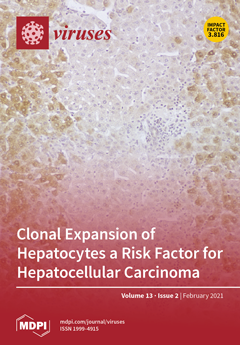Hepatitis delta virus (HDV) coinfection will additionally aggravate the hepatitis B virus (HBV) burden in the coming decades, with an increase in HBV-related liver diseases. Between 2018 and 2019, a total of 205 HBV patients clinically characterized as chronic hepatitis B (CHB;
n
[...] Read more.
Hepatitis delta virus (HDV) coinfection will additionally aggravate the hepatitis B virus (HBV) burden in the coming decades, with an increase in HBV-related liver diseases. Between 2018 and 2019, a total of 205 HBV patients clinically characterized as chronic hepatitis B (CHB;
n = 115), liver cirrhosis (LC;
n = 21), and hepatocellular carcinoma (HCC;
n = 69) were recruited. HBV surface antigen (HBsAg), antibodies against surface antigens (anti-HBs), and core antigens (anti-HBc) were determined by ELISA. The presence of hepatitis B viral DNA and hepatitis delta RNA was determined. Distinct HBV and HDV genotypes were phylogenetically reconstructed and vaccine escape mutations in the “a” determinant region of HBV were elucidated. All HBV patients were HbsAg positive, with 99% (
n = 204) and 7% (
n = 15) of them being positive for anti-HBc and anti-HBs, respectively. Anti-HBs positivity was higher among HCC (15%;
n = 9) compared to CHB patients. The HBV-B genotype was predominant (65%;
n = 134), followed by HBV-C (31%;
n = 64), HBV-D, and HBV-G (3%;
n = 7). HCC was observed frequently among young individuals with HBV-C genotypes. A low frequency (2%;
n = 4) of vaccine escape mutations was observed. HBV-HDV coinfection was observed in 16% (
n = 33) of patients with the predominant occurrence of the HDV-1 genotype. A significant association of genotypes with alanine aminotransferase (ALT) and aspartate aminotransferase (AST) enzyme levels was observed in HBV monoinfections. The prevalence of the HDV-1 genotype is high in Vietnam. No correlation was observed between HDV-HBV coinfections and disease progression when compared to HBV monoinfections.
Full article






